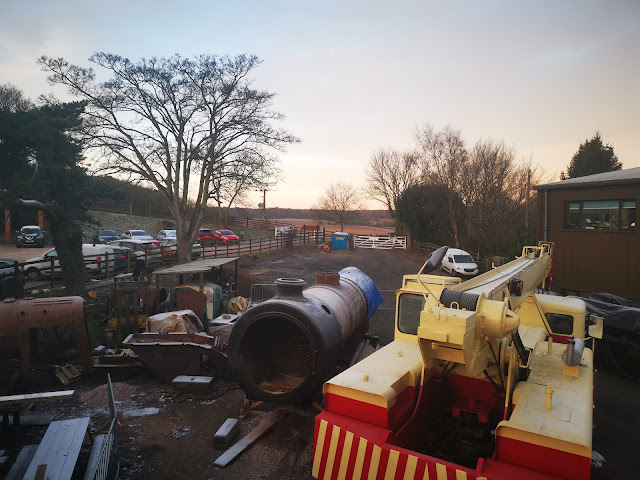It's Wednesday, and I'm back at Weybourne for another day of winter loco maintenance. We're all parked in the station car park today as Trackwork have taken over the yard, and I'm in the car as it's several degrees below zero today.
The WD is coming apart - the guys have removed the cylinder and valve covers and have removed the driver's side piston.
I made some tea, and stood around in front of the heater listening to the banter and waiting to find out what my task for the day was to be, increasingly sceptical as I learned that as the smallest there, I was to go into the tender tanks of the 4MT and the WD and clean out all the scale. Eventually I realised that Foreman Alan was not, for once, winding me up and that everyone else was standing on tip toes...
Ah well, I'm always up for a new job and as I don't have any fear of small spaces I climbed up onto the top of the WD tender with a bucket, a small shovel and a scraper. Fitter Alex gave me some tips about working my way through the labyrinthine passages and told me that the water was less deep towards the front.
I dived in.
It's like this all the way through - bracing stays and panels to stop the water sloshing about and the roof gets lower as you crawl towards the front, scraping off loose scale as you go. At the front, there is the single strainer for the two injectors.
I took two full buckets of rusty sludge out of the WD, lowering my bucket to the ground on a rope.
The 4MT tender is much easier to get through and has less sludge in it, though it's more of a stretch to get in and out. The string shows the way out.
At the front of this one, there is the ball float and the mechanism that operates the level gauge:
There's a strainer on each side above the water valves leading to the injectors:
You can see them here, between the two tender wheels:
There are also two mysterious pipes:
These are for the external filling points, one each side, to allow the loco to be filled from a water tanker when on main line duty. Stations don't have water tanks and cranes these days!
I dumped the sludge in the holes around the yard:
With those done, I transferred my energies to scraping gunge off the 4MT. Driver Dave had been in the day before and done most of the brake gear, leaving the weighshafts for the two brake cylinders for me, along with the axles and the brake hangers.
Fitter Tom was underneath as well, cleaning out the axle box underkeeps:
At lunch, I went outside to take a picture of the ongoing track work. As you can see, the track is up and the old ballast is being removed:
After lunch, It's back to the 4MT and the never ending gunge. I spent most of the afternoon cleaning up the leading pony truck, which was very oily & greasy.
I must figure out how these horizontal springs work.
Same time, same place next week?
















You have our sympathy. Suggest boots with built up soles for future shut downs
ReplyDelete